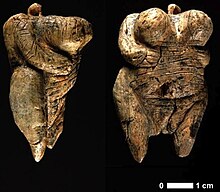Venus of Hohle Fels
| Venus of Hohle Fels | |
|---|---|
 Two views of the Venus of Hohle Fels figurine, which may have been worn as an amulet, and is the earliest known, undisputed example of a depiction of a human being | |
| Material | Mammoth ivory |
| Size | Height: 6 cm |
| Created | 41.000 years ago |
| Discovered | September 2008 Baden-Wurttemberg, Germany |
| Present location | Blaubeuren, Baden-Wurttemberg, Germany |
The Venus of Hohle Fels (also known as the Venus of Schelklingen; in German variously Venus vom Hohlen Fels, vom Hohle Fels; Venus von Schelklingen) is an Upper Paleolithic Venus figurine made of mammoth ivory that was unearthed in 2008 in Hohle Fels, a cave near Schelklingen, Germany, part of the Caves and Ice Age Art in the Swabian Jura UNESCO World Heritage Site. It is dated to between 42,000 and 40,000 years ago,[1][2] belonging to the early Aurignacian, at the very beginning of the Upper Paleolithic, which is associated with the earliest presence of Cro-Magnons in Europe.
The figure is the oldest undisputed example of a depiction of a human being. In terms of figurative art only the lion-headed,
Context
The
This concentration of evidence of full
Discovery
| External videos | |
|---|---|
The discovery of the Venus of Hohle Fels by the archaeological team led by Nicholas J. Conard of Universität Tübingen Abteilung Ältere Urgeschichte und Quartärökologie pushed back the date of the oldest known human figurative art,[a] by several millennia,[b] establishing that works of art were being produced throughout the Aurignacian Period.[8]
The remarkably early figurine was discovered in September 2008 in a cave called
In 2015, the team presented two further pieces of carved mammoth ivory discovered at the site that have been identified as parts of a second female figurine.[10]
Description
The figurine was sculpted from a woolly mammoth tusk and it has broken into fragments, of which six have been recovered, with the left arm and shoulder still missing. In place of the head, the figurine has a perforated protrusion, which may have allowed it to be worn as an amulet.
Interpretation
The discoverer, anthropologist Nicholas Conard, said: "This [figure] is about sex, reproduction... [it is] an extremely powerful depiction of the essence of being female".
Anthropologists from Victoria University of Wellington have suggested that such figurines were not depictions of beauty, but represented "hope for survival and longevity, within well-nourished and reproductively successful communities",[13] reflecting the conventional interpretation of these types of figurines as representing a fertility goddess.
See also
- List of Stone Age art
- Löwenmensch figurine
- Prehistoric art
- Venus of Berekhat Ram
- Venus of Tan-Tan
- Venus of Willendorf
- Venus of Dolní Věstonice
Notes
- ^ The grid or cross-hatch patterns found engraved at the Blombos Cave in South Africa, dating to 75,000 years ago, may or may not be considered "abstract art".
- ^ by at least 5,000 years, if the 35,000 BP date is compared to that of the Venus of Galgenberg, or by as much as 10,000 years if the 40,000 BP date is accepted.
References
- ^ "Archäologie erleben - Mission Eiszeit | SWR Geschichte & Entdeckungen". YouTube.
- ^ ""It must be a woman" - The female depictions from Hohle Fels date to 40,000 years ago..." Universität Tübingen. July 22, 2016. Archived from the original on October 11, 2016. Retrieved July 26, 2016.
- ^ "Work carved from mammoth ivory has been redated and 1,000 new fragments discovered—but it won't make it to British Museum show". Archived from the original on August 10, 2014. Retrieved August 23, 2014.
- ^ a b "Earliest music instruments found". BBC News. 2012-05-25.
- ^ Älteste Menschenfigur der Welt gefunden[permanent dead link] Südwestrundfunk 14 May 2009.
- ^ "Schwäbische Alb: Älteste Flöte vom Hohle Fels".
- ^ "Prehistoric pin-up". Nature. Retrieved April 16, 2013.
- ^ Henderson, Mark (2009-05-13). "Prehistoric female figure 'earliest piece of erotic art uncovered'". The Times. Retrieved 2009-05-13.
- S2CID 205216692.
- ^ "Fragments of a 40,000 year old female figurine found in Hohle Fels". Past Horizons. 22 July 2015. Archived from the original on 30 December 2016. Retrieved 15 December 2016.
- ^ "The Cave Art Debate". The Smithsonian. Archived from the original on 29 October 2013. Retrieved 23 October 2013.
- ^ Wilford, John Noble (13 May 2009). "Full-Figured Statuette, 35,000 Years Old, Provides New Clues to How Art Evolved". 2009. New York Times. Retrieved 23 October 2013.
- .
Further reading
- "Venus of Hohle Fels (38,000 - 33,000 BCE)". Encyclopedia of Art Education (Visual-Arts-Cork).
- Neil Patrick (8 Jun 2016). "The Venus of Hohle Fels is the oldest statue depicting a woman's figure". The Vintage News.
- Cook, Jill (2013), Ice Age Art: the Arrival of the Modern Mind; [... to accompany the exhibition of the British Museum from 7 February to 26 May 2013]. London: British Museum Press. ISBN 978-0-7141-2333-2
